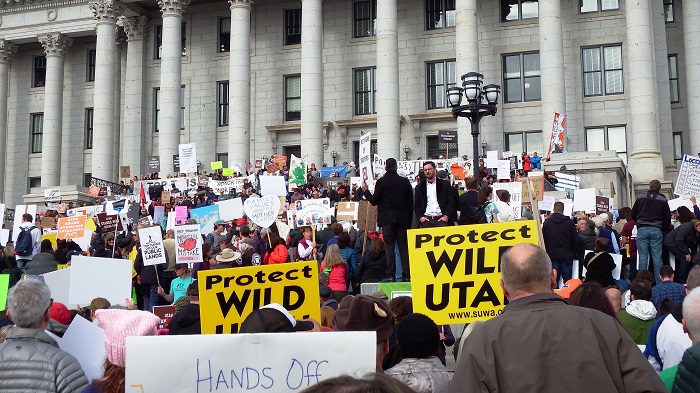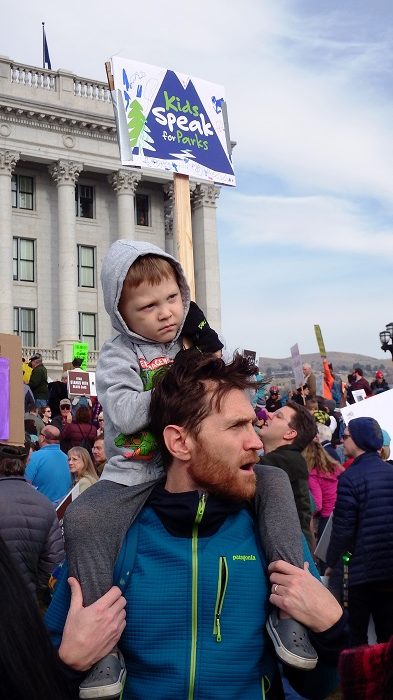
Saturday, December 2nd, 2017—The south lawn of the State Capitol Building swarmed with 5000 protesters concerned about the future of two of the country’s largest national monuments—Bears Ears and Grand Staircase-Escalante—areas considered by many to be the crown jewels of the nation’s public lands network, and the largest undefiled natural areas remaining in the contiguous 48 states. Both monuments are in southern Utah’s incomparable redrock country.
Hoisting signs that said “Keep your tiny hands off my public lands” and “Don’t Trump our monuments,” among others, a diverse gathering of concerned Utahn’s formed a united front to renounce President Donald Trump’s plans to significantly shrink the geographical boundaries of both monuments based on recommendations by Interior Secretary Ryan Zinke, who visited them earlier this year.
Drum beats punctuated the chilly December air as Utah tribes performed ceremonial dances preceding the event which was sponsored by a tribal coalition and a bevy of environmental groups including the Southern Utah Wilderness Alliance (SUWA), Utah Diné Bikéyah, Mormon Environmental Stewardship Alliance, and 13 others.
Navajo prayers were offered at invocation and benediction. Speakers included members of the Bears Ears Inter-Tribal Coalition, Ethel Branch, attorney general of the Navajo Nation, State Representative Patrice Arent, geologist Christa Sadler, and Salt Lake City Mayor Jackie Biskupski. Attendees were encouraged to text and tweet their representatives and the president with photos and comments in favor of keeping the monuments as they are, and decrying their downsizing as a “monumental mistake.”
The 10-year-old founder of Kids Speak for Parks, Robbie Bond, charmed the crowd with his youthful exuberance as he described his visits to Grand Staircase and Bears Ears—lands considered sacred by Utah’s five indigenous tribes.
Under the 111-year-old Antiquities Act of 1906, American presidents can, without congressional approval, protect lands containing items of natural, historical, or cultural significance, of which Utah has many, although not everyone is supportive of those protections.
Also on Saturday, in Monticello, a pro-Trump, anti-monument rally was held. Residents living near the contested areas consider monument designations as infringements that bar previously unregulated uses of the land such as grazing, mineral extraction, and unrestricted access. Citing federal overreach, those opposing the monuments resist federal protection as an economic hardship and a deterrent to the future growth of their communities.
In a reversal of the designations made by Presidents Bill Clinton, who established the Grand Staircase in 1996, and Barack Obama, who established Bears Ears one year ago this month, the Trump Administration, with its ties to Big Energy and fueled by Utah’s republican delegation, sees these protected lands as rich resource repositories of coal, oil and uranium that are presently out of reach.
Under Trump’s plan, these redrock monuments would be collectively reduced in size from 3.2 million acres to 1.2 million acres. Grand Staircase would be downsized and fractured into several smaller monuments, and protections would be dropped from the Kaiparowits Plateau with its rich coal deposits. Monument proponents fear the plateau could become a target for strip-mining by the state despite the infeasibility of extracting and transporting coal from such a remote location.
 Environmentalists allege that the monuments were created by democratic presidents in opposition to the wishes of Utah’s primarily republican legislature, making them easy targets for a president beholden to the fossil fuel industry and hell-bent on erasing the environmental legacy of his “liberal” predecessors. Utah republicans, most notably Representative Rob Bishop and Senator Orrin Hatch, led the charge to downsize or rescind the monuments even before Trump was elected.
Environmentalists allege that the monuments were created by democratic presidents in opposition to the wishes of Utah’s primarily republican legislature, making them easy targets for a president beholden to the fossil fuel industry and hell-bent on erasing the environmental legacy of his “liberal” predecessors. Utah republicans, most notably Representative Rob Bishop and Senator Orrin Hatch, led the charge to downsize or rescind the monuments even before Trump was elected.
Many legal scholars insist that the Antiquities Act, with its virtually unrestricted power allowing sitting presidents to create monuments, has no provision allowing a subsequent president to revoke previous designations, and claim that Trump is breaking the law.
Locals maintain that they are the best stewards of these lands. Many families trace their lineage back several generations, living on ground that was homesteaded soon after the arrival of their pioneer ancestors more than a hundred fifty years ago.
Native Americans claim the most compelling legacy. Their ancestry reaches back thousands of years, ostensibly granting them the original rights of eminent domain, though with so many treaties and promises broken, their history as the traditional stewards of these lands has been denied many times before. Tribal leaders called Trump’s actions “a slap in the face” to Native Americans.
In a stinging rebuke of the Presidents’ actions, Mayor Jackie Biskupski, a democrat, condemned the President’s plans, but said they are retractable if we fight. “We know that we are judged by what we do to Mother Earth,” Biskupski said, “and the future will judge us by what we leave behind.”
Despite the potential for so much devastation to such pristine places, rally attendees were encouraged to remain positive in the knowledge that collectively, citizens can make a difference if we keep demanding justice.
The President issued his proclamation at the State Capitol on Monday, December 4th. Immediately thereafter, a barrage of lawsuits and injunctions were filed in defense of the monuments.
With stubborn intransigence on both sides, and the fate of these lands in the balance, expect the road ahead to be long and contentious.





